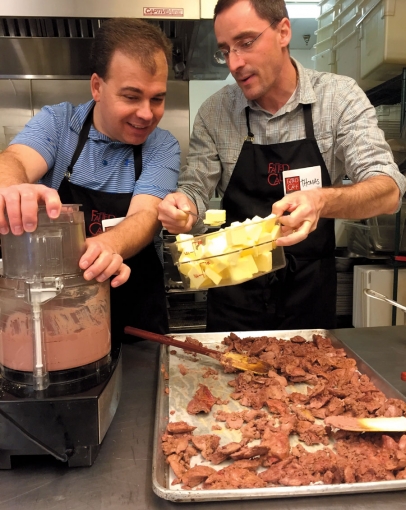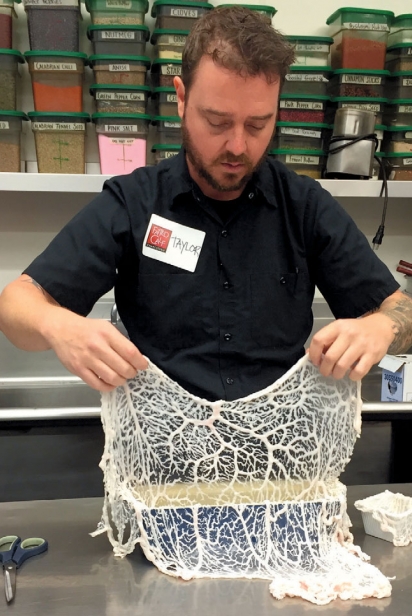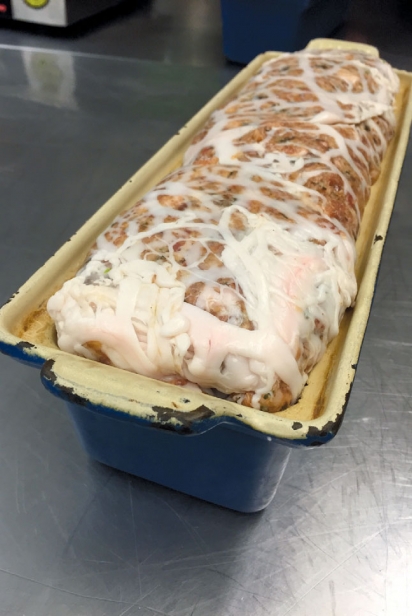High on the Hog
The Fatted Calf ‘s Charcuterie Classes Elevate the Culinary Art of Preserving Meats
Bring the fatted calf, kill it, and let us eat and celebrate…
—From the Parable of the Prodigal Son, Luke 15:23
“Wine is served after knife-work,” Taylor instructed. How disappointing, I muttered, instinctively and immediately searching for the bar anytime I’m issued a name tag. But I was here to learn, and wine could wait until our group lunch at day’s end.
Competent with the rudimentary butchering of whole animals, the stone sharpening of various knives, the stuffing of sausages and the aging of salumi, I’ll even concede there have been some years my prosciutto has been edible. But I was wholly intimidated by the innards of terrines, and frightened by the darkness of liver mousses. Were the livers from birds who ate and drank and smoked with a velocity similar to mine? And who knows what mystery meats are buried inside a jar of rillettes?
A firm believer in learning from masters of their domains, I was over the moon to learn the artisanal charcuterie Fatted Calf offered classes, and specifically one focusing on terrines, mousses and rillettes. Established in 2003 by the culinarily accomplished husband and wife team of chefs Taylor Boetticher and Toponia Miller, Fatted Calf produces handcrafted products using high-quality, natural ingredients sourced from some of the finest farms in the world.
Quite simply, charcuterie is meat, primarily pork and game birds, that has been preserved using techniques such as curing in salt or brine, smoking, potting in fat, sealing with lard and even baking into pastry dough. The goal is to prevent spoilage from airborne bacteria, thereby extending the life of the meat; the autumn pig slaughter or bird hunt made into food to sustain through long winters and hedge against barren early springs. Over thousands of years, charcuterie has transitioned itself from the rustic and life sustaining to the posh and soul enriching.
I’ll admit to tearing up in front of Fatted Calf ‘s stupendous meat case in Napa’s Oxbow Public Market, and of being in awe of the selections at their San Francisco storefront. I’ll even cop to blubbering a bit when their book, In the Charcuterie (Ten Speed Press, 2013), arrived on my doorstep. Ripped from its shipping box, the packing materials lay on the floor at my feet for hours as I paged through the book’s enticing recipes and admired its moody photos, evoking 17th century Dutch Baroque paintings.
And while their book had detailed recipes for terrines and rillettes, mousses and pâtés, each an integral part of the charcuterie’s larder, I remained skeptical of my skills, unsure of my ability to create products worthy of their high-quality ingredients and the time necessary to prepare them.
I needed mentoring.
Each student, 10 of us in all, was swaddled in a black monogrammed apron and stuck with aforementioned name tag. Standing under a wall of shelves lined with labeled containers housing a colorful palette wheel of spices, salts and curing powders, Taylor outlined the day’s recipes, starting us on pork rillettes.
Giant stainless steel bowls of Boston pork butt were laid before us, the pork cooked a day prior for several hours in spices and a gluttonous three-pound mixture of duck fat, foie gras and pork lard. The liquefied fat was strained away from the meat and a thick gelée settled to the bottom of the container, the crème de la crème of fats. Taylor described this highly prized, dense gel as a precious golden jus, often fought over by butchers. He went on to explain that ratios of fat and salt are key to both preservation and flavor, while everything else (spices, choice of meats and cuts, addition of mushrooms, etc.) is window dressing—the proverbial lipstick on a pig. We shredded the pork butt by hand, gobbling up mouthfuls of the warm meat, the savory equivalent of midweek afternoon sex; its sway merciless, somehow indecent, richly decadent.
The Boston butt is butchered from the high front leg and into the upper part of the pig’s shoulder. Most often used for pulled pork in barbecue joints across the American South, the Boston butt earned its name during Colonial times, as New England butchers took the less prized cuts of pork, such as the shoulder, and packed them into casks or barrels called butts for storing and transport on ships. This New England specialty cut became known as Boston butt—except, ironically in Boston, where it’s referred to simply as pork butt.
Taylor was full of these meaty tidbits and stories. Hired to work in the kitchen at Berkeley’s Café Rouge, he wound up running the butchery, establishing a lifelong pursuit of producing charcuterie of caliber. I recall in mouthwatering detail the flavors of Café Rouge’s beef jerky made on his culinary watch: a thicker-cut, leathery slab of spiced meat against which all others should be judged.
We slowly incorporated more than a third of the Boston butt’s strained liquefied fat back into the shredded meat. It was absorbed at a snail’s pace, providing me enough time to make a meal from heels of baguette slathered with the rillettes; mix, eat, mix, eat. A large dollop of the lardaceous golden gelée was then worked into the mixture, already lousy with fat, guaranteeing a smooth, creamy and luxurious texture. We refrigerated small ramekins from each bowl to test for a final seasoning, as cold foods need to be seasoned more aggressively than hot. As with an ice-cold Chardonnay, the flavors are more muted.
We added a bit more salt before packing Mason jars tightly with the concoction, ensuring no air pockets existed where bacteria could form. Each jar was topped with a ladle of the liquid fat, forming an anaerobic layer, before being lidded. Refrigerated, rillettes can be kept for several months and vastly improve in flavor after the first week.
Stoned in a pork and duck fat stupor, I steadied myself against a wall, watching my fellow students cube yet more pork fat, pork shoulder, bacon and black trumpet mushrooms for our next recipe: a rustic terrine. The pig’s liver, having been soaked overnight in milk, was also chopped and added, along with a spice drawer’s worth of flavors: ginger, piment d’espelette, mustard seeds and nutmeg, carefully measured.
My horrific xenophobic assumptions were yet again challenged when I realized three of my fellow students were born-and-bred Frenchmen. I wrongly assumed that, like properly tying a chic scarf or eating only one croissant (and that without getting covered in flaky crumb), most French children are trained in these specific culinary preparations. Instead, each of these recent transplants to the Bay Area had no experience preparing pâté, terrine or rillettes either, but was desirous of making a connection with the cuisine of their homeland.
And like with all of my small-minded assumptions, I stood corrected on another front that day, as well: While the French may have perfected the terrine in the 16th century, the preparation actually dates back thousands of years to the Greeks and Romans. It was a favorite food of laborers, as it’s dense, nutritious and inexpensive, utilizing every precious scrap of the animal. Indeed, I was struck by Taylor’s conscientious frugality, using every bit of meat and not wasting a dollop or a smear, the butchers’ ethos.
During the Middle and Modern ages, fields were hunted for the terrine’s ingredients: Boar, deer and wild game birds such as partridge, pheasant and grouse lent their flavors of gamy rusticity. More contemporary, less frugal, chefs will often layer in duck, foie gras and truffles to approximate that ancient flavor profile.
Terrine refers to both a covered and glazed earthenware baking vessel and to the meat pie that’s cooked within. The dish can be lined with either a fat or pastry, making it easy to remove, while baking in flavor and moisture.
At Fatted Calf, we were given sheaths of white caul fat, evocative of a huge spider’s web, with which to line our baking dish. This thin, translucent membrane, once a covering for a pig’s intestines, now served as the terrine’s lacy lingerie, keeping the loaf intact and eventually melting into the cooked meat. We layered in the chopped pork, back fat, off al and mushrooms and wrapped it snug in the caul fat, trimming off the excess, like a macabre holiday present. We lidded our terrines and put them into a hot water bath, or bain-marie, which evenly distributes heat throughout the terrine while it cooks in the oven, but does not allow it to brown.
While I’ve been told that terrine will last a couple of days in the refrigerator, it’s doubtful it’ll linger that long at my house. Plotting the next day’s lunch, I envision this terrine, cut into fat slices like a meaty pound cake, coming to room temperature on an old wooden board, served with tiny sweet and sour pickles, crusty day-old bread, grainy mustard and large bottles of aged cru Beaujolais.
There is no such thing as “whipping up a terrine.” The meat needs a day to marinate, a day to assemble and cook, and a day to cool and allow the flavors to harmonize—a Bach concerto composed over many days. A labor-intensive, special-occasion food, Taylor stressed the importance of making a game plan, gathering the best ingredients and taking the time to properly construct it. Like building a boat, if you’re going to bother, it better be good. Or you’re sunk.
We began Fatted Calf ‘s duck liver mousse recipe, the day’s last, by melting rendered duck fat in a huge cast-iron skillet and adding duck livers that had been seasoned overnight. Once the livers had been sautéed to a rosy pink, we blended in yet more fat in the form of butter and the unctuous golden gelée before forcing the creamy mixture through a fine-mesh sieve, ensuring cloudlike consistency. The final addition to this mousse fit for royalty? Heavy cream whipped to peaks, doused with good Armagnac and folded into the creamy liver mixture, its hue fittingly the dark purple of nobility. It required only a cracker and a glass of red Burgundy, preferably one from a leaner year. Shamelessly, I licked the spoon clean.
With aching feet, redolent of meat, hands and chins glistening with fat, the class sat down together for a late lunch. Platters of roasted pork with crackling skin, a clayware crock of Rancho Gordo cannellini beans spiked with tomato and pancetta, a gargantuan bowl of the duck liver mousse, and various sautéed vegetables filled our communal table. On my plate was only the smallest pile of crispy kale, but my glass was finally filled with wine.
Author’s Note: Learning to properly wield a shotgun, stone-sharpen a knife, clean a pheasant or white-tailed deer, grow a spicy radish or bitter chicory, and debone the halibut I reeled in, allows me the ability to raise a fist against factory farming, to communicate with the cycles and seasons of nature and with the unusual people who speak in the same, impassioned tongue.









